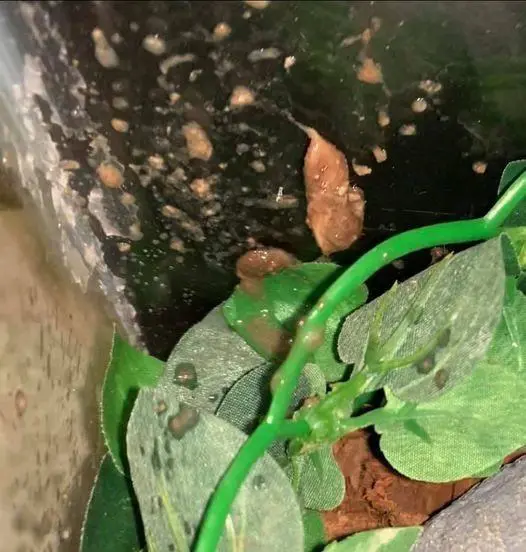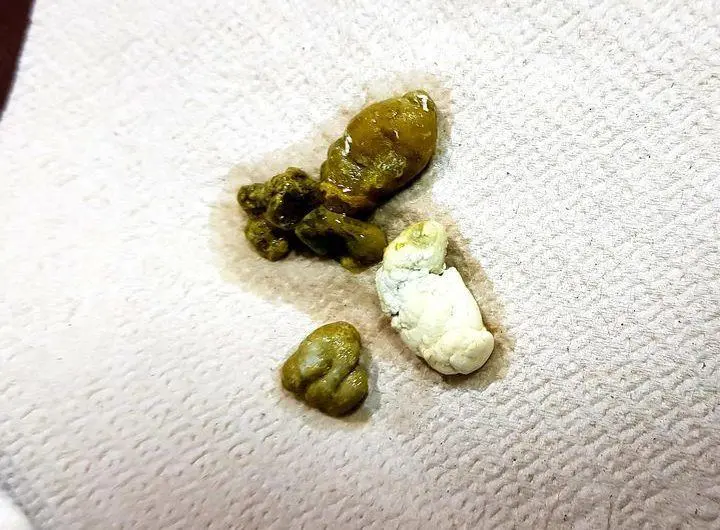Getting to know your ball python poop is important, enabling you to identify when things are not quite right. Normal ball python poop is tubular with an irregular surface and may be pinched. It is dark in color and has white streaks of dried urates.
After a while, you will get to know your pet’s poop with your regular cleaning, which will enable you to quickly identify if the poop is abnormal.
Diarrhea needs quick treatment, often including a fecal sample to be sent to the vet for analysis.
Ball Python Diarrhea Symptoms
If your ball python has diarrhea, you will find out relatively quickly. The signs and symptoms of diarrhea include:
- Runny poop, not tube-like inconsistency
- Foul smell coming from the enclosure
- Multiple poops between meals, not just one big poop
- Lethargy may be seen if your pet has been struggling for a while


Ball python normal poop
Causes
As with any animal or human, there are numerous causes that can result in diarrhea in your ball python.
Parasites
Parasites are the most common cause of diarrhea in ball pythons.
Internal parasites, such as worms and coccidia, along with external parasites, such as mites and ticks can cause no clinical signs, but they can also cause diarrhea, regurgitation, itching, mouth rot, weight loss, breathing problems, and internal organ swelling.
Malnutrition
Diarrhea can also be a result of your pet not getting a well-balanced diet. Malnutrition is serious and can cause diarrhea in your pet.
Cage Conditions
A dirty enclosure that is not cleaned on a regular basis can cause your pet to get diarrhea. Ball pythons need clean living conditions in order to reduce stress. Stress can lead to diarrhea if the enclosure is not spot cleaned daily with a monthly deep clean.
Related – Signs of a stressed ball python.
Humidity and Temperatures
When your pet is exposed to incorrect temperature and humidity levels, they will become stressed, again this can result in your pet experiencing diarrhea.
Treatment
Vet
Most ball python owners will take a sample of their pet’s runny poop and take it to the vet for analysis. This should be done if you think your pet has parasites, as they are not always easy to eradicate.
Diet
Change your pet’s diet. It is possible that your pet has eaten a mouse that isn’t healthy and has made it sick. Ensure you provide a healthy diet based on the size of your snake, ensuring you reduce the risk of malnutrition.
Habitat
Do a thorough clean of the habitat to ensure you remove any potential causes for diarrhea, such as a dirty habitat, poop you haven’t picked up or noticed and to try and eradicate some of the mites or ticks that may have invaded the enclosure.
Humidity and Temperatures
Check your temperatures and humidity levels are at optimum and make the necessary changes to ensure your pet has the most comfortable habitat and help reduce unnecessary stress.
Prevention
Diet
Ensure you are providing your pet with the right size prey based on its size and weight. This will ensure your pet doesn’t experience malnutrition and remains healthy.
Habitat
A clean habitat reduces the risk of your python stressing. Foul smells and dirt in the enclosure are worrying for your pet. In the wild, it would attract predators.
Daily Spot Cleaning
The enclosure should be spot cleaned daily, removing any poop and dirt from the enclosure. If you are using paper towel as a substrate, remove this and replace.
Monthly Deep Cleaning
Once a month, you should remove everything from the enclosure, wash down the enclosure with a reptile disinfectant, soak all the accessories, and clean with disinfectant, and once everything is clean, dry, and replaced you can return your pet to its habitat.
Humidity and Temperature
Maintaining optimum humidity levels and temperatures are important to help your pet stay strong and healthy. Use digital thermometers and hygrometers, which will make it quick and easy to monitor that your temperature and humidity remain at optimum.
Optimum Temperatures
- Basking area – 88ºF to 92ºF
- Warm side – 80ºF to 85ºF
- Cool side – 75ºF to 80ºF
Optimum Humidity Levels
You want to ensure you keep your humidity levels between 50% and 65%. Misting the enclosure can help you achieve these levels, alternatively, if you are struggling with humidity, add your water bowl to the warm side of the enclosure.
Summary
If you know your pet, you will quickly identify if it has diarrhea. Prevention is always better than cure in these situations.
Maintaining optimum temperatures and humidity, keeping the enclosure clean, and providing a healthy diet based on the weight of your pet can reduce the risk of diarrhea.
If your python develops this take him to see a specialist right away. I didn’t and my snake died after two weeks of him constantly pooping. It was very sad.
What treatment can i give i have on vet in my town and she doesn’t treat snakes